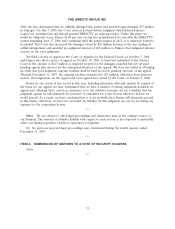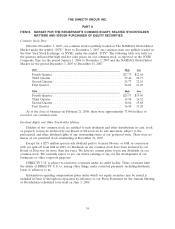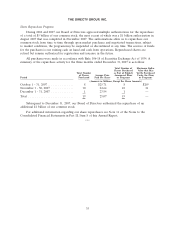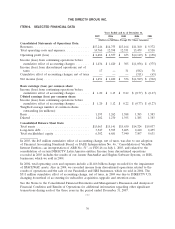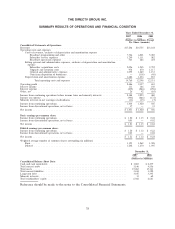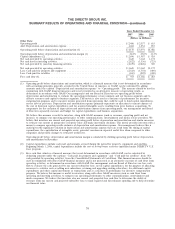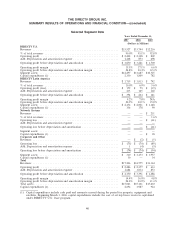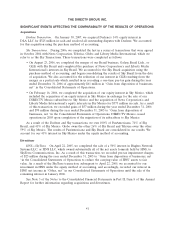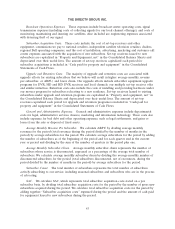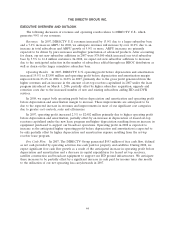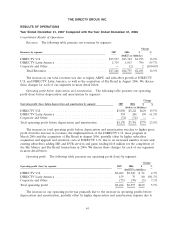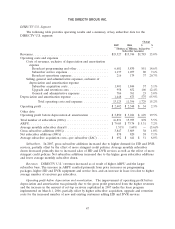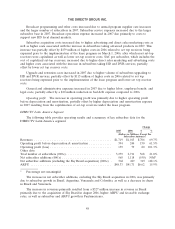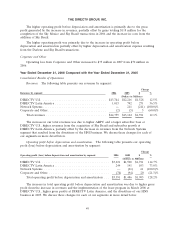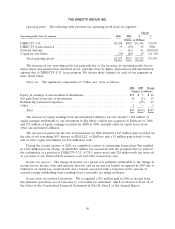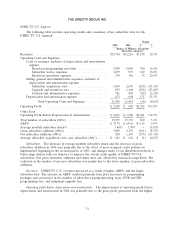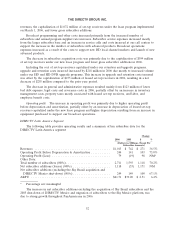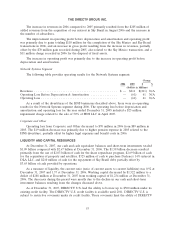DIRECTV 2007 Annual Report Download - page 52
Download and view the complete annual report
Please find page 52 of the 2007 DIRECTV annual report below. You can navigate through the pages in the report by either clicking on the pages listed below, or by using the keyword search tool below to find specific information within the annual report.THE DIRECTV GROUP, INC.
Broadcast Operations Expenses. These expenses include broadcast center operating costs, signal
transmission expenses (including costs of collecting signals for our local channel offerings), and costs of
monitoring, maintaining and insuring our satellites. Also included are engineering expenses associated
with deterring theft of our signal.
Subscriber Acquisition Costs. These costs include the cost of set-top receivers and other
equipment, commissions we pay to national retailers, independent satellite television retailers, dealers,
regional Bell operating companies, and the cost of installation, advertising, marketing and customer call
center expenses associated with the acquisition of new subscribers. Set-top receivers leased to new
subscribers are capitalized in ‘‘Property and Equipment, net’’ in the Consolidated Balance Sheets and
depreciated over their useful lives. The amount of set-top receivers capitalized each period for
subscriber acquisitions is included in ‘‘Cash paid for property and equipment’’ in the Consolidated
Statements of Cash Flows.
Upgrade and Retention Costs. The majority of upgrade and retention costs are associated with
upgrade efforts for existing subscribers that we believe will result in higher average monthly revenue
per subscriber, or ARPU, and lower churn. Our upgrade efforts include subscriber equipment upgrade
programs for DVR, HD and HD DVR receivers and local channels, our multiple set-top receiver offer
and similar initiatives. Retention costs also include the costs of installing and providing hardware under
our movers program for subscribers relocating to a new residence. Set-top receivers leased to existing
subscribers under upgrade and retention programs are capitalized in ‘‘Property and equipment, net’’ in
the Consolidated Balance Sheets and depreciated over their useful lives. The amount of set-top
receivers capitalized each period for upgrade and retention programs is included in ‘‘Cash paid for
property and equipment’’ in the Consolidated Statements of Cash Flows.
General and Administrative Expenses. General and administrative expenses include departmental
costs for legal, administrative services, finance, marketing and information technology. These costs also
include expenses for bad debt and other operating expenses, such as legal settlements, and gains or
losses from the sale or disposal of fixed assets.
Average Monthly Revenue Per Subscriber. We calculate ARPU by dividing average monthly
revenues for the period (total revenues during the period divided by the number of months in the
period) by average subscribers for the period. We calculate average subscribers for the period by adding
the number of subscribers as of the beginning of the period and for each quarter end in the current
year or period and dividing by the sum of the number of quarters in the period plus one.
Average Monthly Subscriber Churn. Average monthly subscriber churn represents the number of
subscribers whose service is disconnected, expressed as a percentage of the average total number of
subscribers. We calculate average monthly subscriber churn by dividing the average monthly number of
disconnected subscribers for the period (total subscribers disconnected, net of reconnects, during the
period divided by the number of months in the period) by average subscribers for the period.
Subscriber Count. The total number of subscribers represents the total number of subscribers
actively subscribing to our service, including seasonal subscribers and subscribers who are in the process
of relocating.
SAC. We calculate SAC, which represents total subscriber acquisition costs stated on a per
subscriber basis, by dividing total subscriber acquisition costs for the period by the number of gross new
subscribers acquired during the period. We calculate total subscriber acquisition costs for the period by
adding together ‘‘Subscriber acquisition costs’’ expensed during the period and the amount of cash paid
for equipment leased to new subscribers during the period.
43


